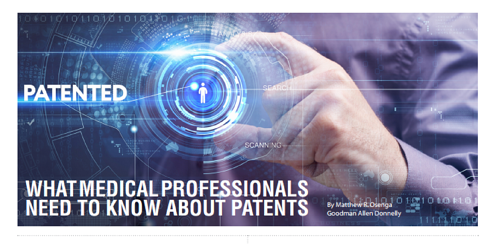
A patent is a property interest granted by the federal government that permits the inventor to exclude others from using, making, selling, offering for sale, or importing the patented invention in the US for a limited time. This limited monopoly is granted in exchange for full disclosure of how to make and use the invention. The purpose of this disclosure is “to promote the Progress of Science and useful Arts.” The public benefits because it can build upon this knowledge, while the inventor benefits by the limited monopoly.
A patent can be obtained for a new and useful “process, machine, manufacture, or composition of matter, or any new and useful improvement thereof.” Thus, a patent can be obtained for a new medical device, drug, biological agent, or method of treating, diagnosing, or administering medical services to a patient.
The Patent Act requires the invention be new or novel, useful, and non-obvious to those skilled in the art to which the patent pertains. The patent must include a complete written description of the invention – including how to make and use it – along with any necessary drawings and a set of one or more claims that designate the metes and bounds of the inventor’s exclusionary rights. A patent can be assigned, licensed, bought, sold, or otherwise transferred in the same way as other property rights.
One who, without the permission of the patent owner, makes, uses, sells, offers for sale, or imports the patented invention, may be liable for patent infringement. The remedy for infringement of a patent is a civil action in federal court. If the patent owner prevails, the infringer may be liable for damages in the form of lost profits or a reasonable royalty. The infringer may also be enjoined from further infringing activities, and may be liable for attorney’s fees. In general, there is no intent requirement for infringement, but if infringement is judged to be willful, the infringer may be liable for up to three times the amount of damages awarded.
There are a number of potential defenses: there is no actual infringement; the patent is invalid because it fails to comply with some provision of the Patent Act; the inventor procured the patent by misstatements to or withholding information from the Patent Office.
What Should You Do?
If you wish to seek a patent, keep the invention confidential until you speak to a patent attorney. The attorney can determine what parties may have rights to the invention, whether the invention may be patentable by conducting a prior art search, whether the patent would be enforceable, and whether there would be defenses to infringement. The prior art search is to see what other patents and publications exist that may disclose the invention. Finally, the attorney can also assist you with the application and drawings, as well as prosecuting the application through the Patent and Trademark Office.
Related post: What to do if you are accused of infringement.
This blog is made available by Goodman Allen Donnelly for general information, and does not constitute legal advice. By reading this blog, you understand that there is no attorney-client relationship between you and the firm. This blog should not be used as a substitute for competent legal advice from a licensed professional attorney in your state.
